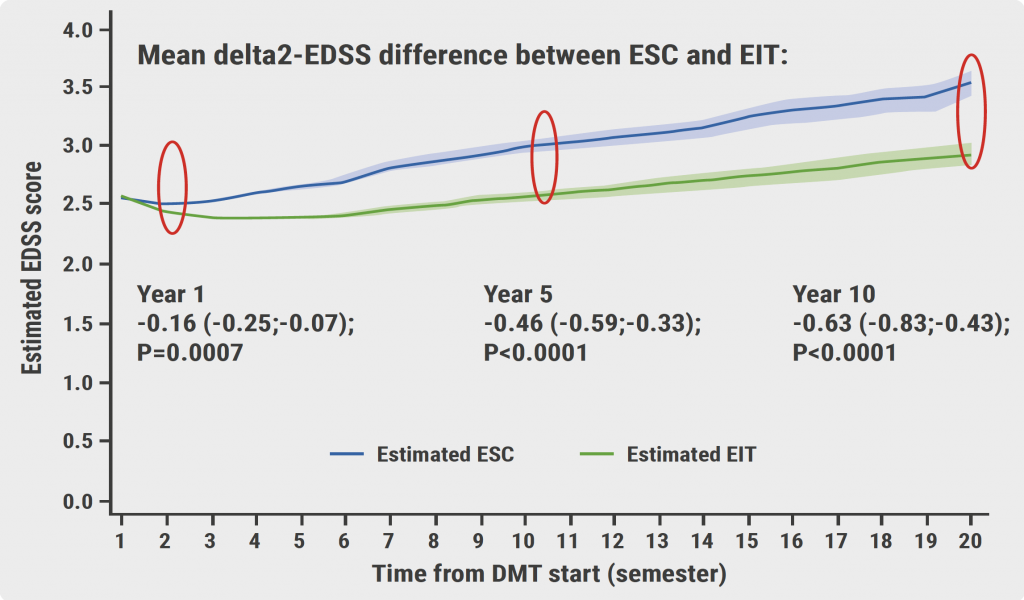Prof. Xavier Montalban (Vall d’Hebron University Hospital, Spain) summarised the 2021 update of the ECTRIMS/EAN guidelines. The update is divided into 8 topics, of which the first is efficacy of disease-modifying therapy (DMT). The following recommendations were included:
- Offer interferon or glatiramer acetate to patients with clinically isolated syndrome (CIS) highly suggestive of MS and an abnormal MRI with lesions suggestive of MS who do not fulfil criteria for MS.
- Offer treatment with siponimod to patients with secondary progressive MS (SPMS) with evidence of inflammatory activity (relapses and/or MRI activity). Treatment with other DMTs used for relapsing MS may also be considered, taking into account their efficacy, the patient's expectations, as well as safety and tolerability issues.
- Consider treatment with siponimod or anti-CD20 monoclonal antibodies for patients with SPMS without evidence of inflammatory activity, particularly in young patients and those in whom progression has started recently.
- Consider ocrelizumab for patients with primary progressive MS (PPMS), particularly in early and active (clinically and/or radiologically) disease.
- Consider treatment with mitoxantrone in patients with active SPMS when there is no other therapy available, taking into account –in discussion with the patient– its efficacy and specifically the well-documented, concerning, safety issues and tolerability profile.
Topic 2 comprised early treatment decisions. One of the recommendations is to consider choosing a higher efficacy DMT early on, according to disease activity (either clinically or on MRI) and patient particulars.
Topic 3 is disease/treatment response monitoring and treatment modifications. The central recommendation in this topic is to offer a more efficacious drug to patients treated with DMTs who show evidence of disease activity.
Topic 4 is concerned with suspension of treatment and disease reactivation. Prof. Montalban highlighted these 2 recommendations:
- When treatment with a high-efficacy DMT is stopped, either due to inefficacy or risk of adverse events, consider starting another high-efficacy DMT, taking into account the following factors: 1) clinical and MRI disease activity before and during treatment; 2) pharmacokinetics and biological activity of the previous DMT; 3) the potential for resumed disease activity or even rebound, particularly with natalizumab and S1P modulators.
- In the stable patient (clinically and on MRI) who shows no safety or tolerability issues, consider continuing treatment with DMT, taking into account the following patient circumstances: 1) patient characteristics and comorbidities; 2) drug safety profile; 3) family planning; 4) patient values and preferences.
Additional practical issues were addressed in some other topics. For example, when treating patients with natalizumab, and after a period of stability, you can consider switching to a 6-week interval regimen in order to minimise the risk of progressive multifocal leukoencephalopathy (PML). Treatment with high-efficacy DMT including natalizumab can be considered in patients with high disease activity in which a quick therapeutic effect is required, taking into account the risk of PML in John Cunningham virus-positive patients (specifically for natalizumab) as well as the therapeutic lag of the different DMT.
- Montalban X. Updated recommendations on the treatment of patients with MS. OP184, ECTRIMS 2021 Virtual Congress, 13–15 October.
Copyright ©2021 Medicom Medical Publishers
Posted on
Previous Article
« Rituximab most effective initial MS therapy in Swedish real-world study Next Article
MRI more sensitive for disease activity than relapses in SPMS »
« Rituximab most effective initial MS therapy in Swedish real-world study Next Article
MRI more sensitive for disease activity than relapses in SPMS »
Table of Contents: ECTRIMS 2021
Featured articles
Preliminary data shows positive results of ATA188 for progressive MS
COVID-19
MS patients at risk of hampered immune response after vaccination
Immunotherapy in MS does not influence COVID-19 severity and mortality
Anti-CD20 antibodies associated with worse COVID-19 outcomes
ECTRIMS-EAN consensus on vaccination in MS patients
Experimental Treatments
The role of astrocyte phenotypes in acute MS lesions
Promising results of intrathecal MSC-NTF cells in progressive MS
Preliminary data shows positive results of ATA188 for progressive MS
Evobrutinib reduces relapses and MRI lesion activity
Primary endpoint of opicinumab for relapsing MS not met in AFFINITY trial
Elezanumab did not outperform placebo in progressive and relapsing MS
Ibudilast reduced retinal atrophy in primary progressive MS
Treatment Trials and Strategies
ECTRIMS/EAN Clinical Guidelines on MS treatment: an update
Rituximab most effective initial MS therapy in Swedish real-world study
Ublituximab meets primary endpoint for relapsing MS
Dynamic scoring system aids decision to switch MS therapies early
Long-term suppression of MRI disease activity with ocrelizumab
Stopping DMT: when or if at all?
Biomarkers
Early predictors of disability progression in paediatric-onset MS
High-sensitive biomarker detection in MS via novel ELISA assay
Cortical lesions predict cognitive impairment 20 years after MS diagnosis
Applicability of sNfL measurement in clinical practice
MRI more sensitive for disease activity than relapses in SPMS
Imaging
Changes in GABA-receptor binding among cognitively impaired MS patients
T2 lesions independently predict early conversion to SPMS
Natural killer-like CD8+ T cells as a reservoir of clonal cells related to MS activity
Neuromyelitis Optica Spectrum Disorder (NMOSD)
Eculizumab, satralizumab, or inebilizumab for NMOSD?
Long-term efficacy of satralizumab for NMOSD
Long-term efficacy data: inebilizumab for NMOSD
Progressive MS
Charcot Award 2021: Progressive MS, a personal perspective
Top score poster: Meta-analysis on the effect of DMTs
Cortical lesions predict disease progression and disability accumulation
Ocrelizumab shows long-term benefits in primary progressive MS
Other
WNT9B-gene variant associated with doubled relapse risk in MS
Melatonin associated with improved sleep quality in MS patients
“Expanded Disability Status Scale 0 is not normal”
Personality trait alterations in MS patients
Related Articles
August 23, 2021
Tolebrutinib shows early promise in multiple sclerosis
November 8, 2019
Genes, environment, and safety monitoring in using registries

December 4, 2023
Early intensive treatment enhances long-term clinical outcomes
© 2024 Medicom Medical Publishers. All rights reserved. Terms and Conditions | Privacy Policy

